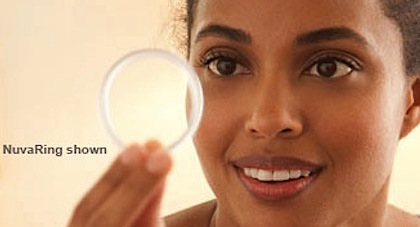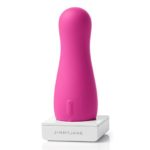
Dr. Kate is an OB/GYN at one of the largest teaching hospitals in New York City. Here’s one of her most popular Em & Lo columns from the archives:
When it comes to hormonal birth control, I get more questions about the NuvaRing than any other method — for proof, just check out the comments sections of my posts “Tell Me About the Nuva Ring” and“Does the Nuva Ring Deserve Its Bad Press.” The ring just doesn’t seem to be as intuitive as the once-a-day-every-day tyranny of the birth control pill. Most women’s questions focus on the timing of the ring, and what happens if their schedule gets thrown off. So, since Em & Lo have put a moratorium on Nuva Ring questions for the time being, here are the 14 points about the Nuva Ring that should hopefully answer any and all questions.
1. When to start it: You can start the ring any time you want…
- If you’re starting it with your period, put in the ring during the first 5 days of bleeding.
- If you’re starting it later than that, or totally off your period, take a pregnancy test first. If negative, begin the ring that day.
- If you’re switching to the ring from the pill or patch (and you completed your pack of pills/box of patches), you can place the ring on the day you would have started your new pack of pills or box of patches.
2. How soon you’re protected: It depends on when you started the ring…
- If you place the ring on the first day of your period, you’re protected immediately.
- If you started the ring at any other time, you need to use condoms for 7 days for maximum contraception protection.
- If you directly switched from the pill or patch to the ring (and you completed your pack of pills/box of patches), you’re protected immediately.
3. The minimum you must leave it in: The ring needs to be in your body for 3 straight weeks. Don’t take it out early if you start bleeding earlier than you expect — the ring needs its three weeks to work. If you remove the ring before the three weeks are up, you’re at risk of pregnancy that cycle.
4. The maximum it can stay in: The ring has enough hormones so that it may be left inside for up to 5 weeks and still be effective. So you’ve got lots of flexibility in how long the ring is in. And you don’t need to use the ring for the same amount of time each cycle — some months you may leave it in 3 weeks, some up to 5 weeks — your body will adjust. But if it’s left in longer than five weeks, you’re now at risk of pregnancy.
5. How long you can leave the old ring out before you put a new one in: When switching between old and new rings, the device cannot be out of your body for more than 7 days — in other words, you need to put a new ring back in by the same day of the week that you removed the old one. This rule holds even if you’re still bleeding — the new ring must be reinserted within a week. (If you want to shorten your ring-free week and, say, put a new one in after 3 or 4 days, that’s fine — you’ll still be protected.)
6. When it’s out for that one week, you’re protected: If you’ve used the ring following these guidelines, you’re still protected against pregnancy during the ring-free week. The ring has suppressed ovulation for that cycle, so you don’t need a back-up method of birth control during the ring-free week (though condoms are always a good idea for infection prevention, whether the ring is in or out).
7. Temporarily taking the ring out for three hours or less: The exception to rule #3: you can remove the ring for up to 3 hours at a time and still be protected against pregnancy. For instance, you can take it out for a gyno visit, sex, or masturbation (some people don’t like the idea of playing ring toss in their vagina), but in each of those cases it isn’t necessary to do so. There are no studies that tell us how often you can take a ring holiday; I counsel my patients that they can remove the ring once a day for 3 hours and are likely still safe.
8. Taking the ring out for more than three hours: If it’s out for more than 3 hours, it’s possible that your ovaries will respond with a quickie ovulation. So put the ring back in and use condoms for a week.
9. If you’re late putting a new ring in: If the old ring has been out for more than 7 days, put the new ring in anyway. Don’t wait for your period to start (so many women become pregnant while they’re waiting!). Then use condoms for 7 days.
10. Using rings back-to-back. You can use a new ring directly after taking out the old one — you don’t need to leave a ring out for any length of time, you don’t need a back-up method, and you can do this indefinitely (no need to ever bleed).
11. Bleeding patterns: It’s normal to have irregular spotting or bleeding during your first few months on a new birth control method. Don’t pull the ring out if you begin to bleed early — it doesn’t mean the ring is “finished,” it’s just breakthrough bleeding while your body is adjusting.
12. Other things in your vagina: Fingers, penises, tampons, sex toys, semen — all okay.
13. You can’t lose it in your body. As long as the ring is all the way in the vagina, and it feels comfortable, you’re good to go. It doesn’t need to be in a particular place to work, and it won’t go in too far.
14. Risk of pregnancy: If you have sex without using the ring correctly, you are at risk of pregnancy. Take a pregnancy test if your period doesn’t come when you expect.
Dr. Kate
Gyotalk
Dr. Kate is an OB/GYN at one of the largest teaching hospitals in New York City. She also lectures nationally on women’s health issues and conducts research on reproductive health. Check out more of her advice and ask her a question at Gynotalk.com.
















